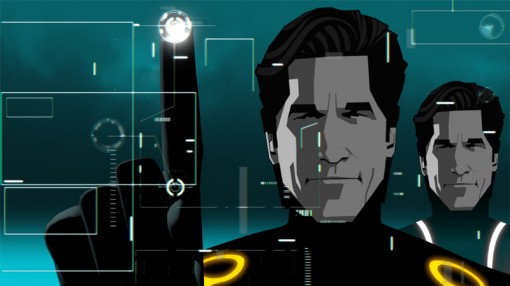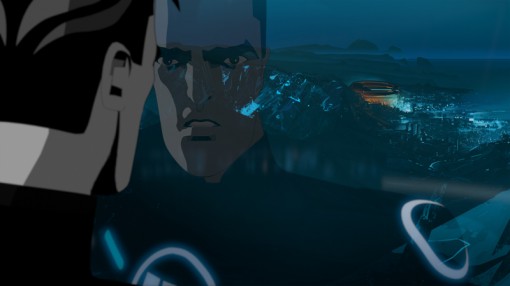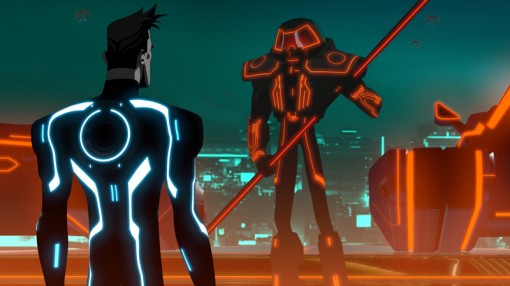Disney XD puts a fresh spin on a sci-fi classic with the new series TRON: Uprising.
You can’t keep a good franchise down: Two years after the theatrical reception of Disney’s TRON: Legacy, which added fresh faces and cool new CG effects to the 1982 sci-fi sensation, a new animated take on the in-game universe called TRON: Uprising will take its place on Disney XD this month.
Following the spectacular half-hour prelude, which aired on the network and Disney Channel in May, the series is set between the events of the original film and the 2010 sequel. Uprising centers on Beck (voiced by Elijah Wood) , a young mechanic living in Argon City in a far corner of The Grid which is under the tyrannical grip of General Tesler (Lance Henriksen), a henchman of the evil Clu. When Beck’s friend is “derezzed” by Clu’s army, he incites a rebellion which draws the attention of Tron (the one and only Bruce Boxleitner), the legendary hero of The Grid, who takes Beck on as a disciple.
The top-notch cast is further aided by Mandy Moore, Emmanuelle Chriqi, Nate Corddry, Reginald VelJohnson, Paul Reubens and Battlestar Galactica’s Tricia Helfer as the narrator and voice of The Grid. The show is produced by Disney Television Animation.
For executive producer and series director Charlie Bean—an animation veteran whose career has spanned Tiny Toon Adventures, Ren & Stimpy, Samurai Jack, Robotboy, SpongeBob SquarePants and The Amazing World of Gumball, and taken him to L.A., Paris and London—the chance to involve himself in the iconic world of TRON was all the incentive needed to call him back from the U.K., where he was creative director for Cartoon Network’s European development studio.

“I had just been to L.A. on holiday and met up with [Mike Moon, VP creative for Disney Television Animation] and he told me about the project … A few days later I was back in London, sitting in a pub and my phone rang. It was Mike, and he said, ‘Remember that TRON thing? The guys from Lost want to meet you.’”
He recalls, referring to Edward Kitsis and Adam Horowitz, the exec producers of Lost who scripted TRON: Legacy and serve as consulting producers on the series with Legacy co-producer Justin Springer.
“I took a sip of beer and said, ‘Uh…uh…I can be there tomorrow!’”
TRON Team: Assemble!
Bean officially came on board at the end of 2009, but before he could dive into The Grid there were some key people he knew he wanted at his side—one of them being art director and production designer Alberto Mielgo, a Madrid-born artist and animator Bean had worked with in London.

“When I got the job, the first call was to Alberto, and the second was the [lead character designer] Rob Valley.”
Mielgo’s recollection is not quite as fond.
“I was sleeping, it was five in the morning!” he interjects during our three-way call. “I was freelance at the time, and as a freelancer you always say yes to everything, but I wasn’t super committed because it was five in the morning. So, he called me again later—and I was like, Charlie, stop this!”
After a little more sleep, Mielgo—whose freelance clients include the likes of WB, DreamWorks, BBC, Playstation and Disney—came on board. As did Valley, whose projects list boasts Peter Chung’s seminal animated sci-fi series Aeon Flux and work for toon rock group Gorillaz.
Other key drivers of the show’s unique look and narrative are lead vehicle designer Daniel Simon, a world-renowned car designer born in Germany who has taken his experiences at Bugatti, Volkswagen and Lotus and translated them into cool vehicle concepts for Hollywood (you can see his work in Captain America and Prometheus) and was charged with delivering animated versions of TRON’s light cycles, light jets and the rest; head writer/story editor Scott Nimerfro, whose credits include Tales from the Crypt, Pushing Daisies, Star Trek: Voyager and X-Men the film; and composer Joseph Trapanese, who collaborated with Daft Punk for TRON: Legacy’s soundtrack in addition to work for TV’s Dexter and Burn Notice and orchestration for Fast Five and Percy Jackson & the Olympians: The Lightning Thief.

Rebuilding The Grid
While Disney had plans for a toon version of TRON for a long while, the concept behind Uprising underwent its share of changes during the roughly year-long development phase with which Bean and Mielgo were involved. Bean explains the series was original conceived as a 10-installment run of three-minute microsodes. But when the micros were edited into a 30-minute episode, the studio realized the feasibility of creating a full on half-hour episodic show. Thus the creative heads managed to create a bit more work for themselves.
“There’s a specific challenge when coming off a live-action film where you don’t want to just do the cheap, animated version … from an artistic point of view, it’s like, what is the point?” Bean explains. “We had to figure out, how can we stylize this in a way that makes sense? What can you do in animation that you can’t do in live-action is the stylization. That’s something we’re figuring out; there’s a million ways to skin a cat.”
The world was, comparatively, easily realized with the live-action film references and the director notes Mielgo’s earliest concept paintings held up through to the final production result. (Concept work the artist created for another sci-fi project that struck Bean as having a “TRON feel” was one of the reasons he wanted Mielgo on the project.) However, the character design evolved quite a bit.
Rob Valley’s involvement early in the process was key, Bean says, because there was a desire to stand out from other animated action-adventure fare on TV. Instead of kid-friendly squashed down characters with large heads and eyes, Valley elongated and stylized the characters while still maintaining a more believable human look. As an homage to the original film, the team also decided to make all the flesh-tones black and white for these inhabitants of the eternally midnight, artificially lit world of The Grid.

To help create a modern look, the character designs were inspired by the street styles of the far-flung team’s cities.
“We stole a lot of hairstyles from Shoreditch,” Bean jokes, referencing the fashionable north London ‘hood.
“Rob’s designs are just so unique, and it was extremely difficult to get his designs to actually look like his drawings in CG. [Achieving that] was a long process and, much to the chagrin of production here, we spent a great deal of time on it.”
For Mielgo, designing this strange nighttime world was a very different task for a toon project.
“Because it’s so dark, you just see the shapes of buildings with some light around—it’s more of an impressionistic approach,” he explains. “In animation it’s hard to make it look realistic, and we had to think a lot about how artificial light behaves, not just in the backgrounds but on the characters and vehicles as well.” The team paid special attention to the interaction of light on the buildings’ glass and lacquered surfaces and integrating the characters into the world believably—luckily, as the duo share, the late night production schedules gave them plenty of chances to observe artificial light glinting off objects in the dark.

Mielgo notes that the greatest challenge for him was marrying his designs into a coherent world that could support the epic season-wide story with believability and appeal.
As with the general scope of the show, the design became more complex as development went on. The blend of CG and 2D animation is handled by Japan’s Polygon Pictures, using Maya and Nuke for compositing, a crucial element in the mixed-technique production.
“With the way compositing is going, you can have completely 2D elements and very traditional techniques—matte painting, multi-plane—and completely realized CG environments. And we use everything, whatever’s right for the scene.” Bean estimates each episode takes roughly eight months to complete.
“Charlie, Rob and I all come from 2D, and we love 2D,” Mielgo adds. “We come from a very graphic world and try to bring our 2D ideas and aesthetic … It’s been nice, we were actually putting things in the heads of the 3D guys [at Polygon] and we’ve been kind of evolving from 2D to 3D thinking, and they are also changing their thinking, so we’re right in the middle.” He notes that they were even able to show the CG team a few cheats and tricks from the traditional animation handbook.
Bean recalls with a wry laugh that when presenting the initial animation test, he had told the impressed viewers that they would be simplifying the designs and animation for the actual series.

“Everyone was like, wow, that’s incredible, how are you going to keep that up? And we were like, no, we won’t … But we ended up pushing beyond that. Like fools.”
The director adds that new obstacles are continue to present themselves on this ambitious show.
“We’re constantly trying to top ourselves, and the writers are not specifically animation writers, so they present us with challenges you wouldn’t normally get in animation. And that’s been exciting … New locations, new vehicles and big set pieces. It’s really pushed the limits of our sleep deprivation.”
“Animation is so flexible, you can do things that you cannot do in live action. From the beginning, ideas from the script, plus your vision, plus my vision—standards are super high,” Mielgo concludes. “It’s really challenging to make it look good, but I think we are accomplishing our goals.”
TRON: Uprising premiers on Disney XD June 7 at 9 p.m., with next day multi-platform availability following.



 Win a Funko X Lilo & Stitch Prize Pack!
Win a Funko X Lilo & Stitch Prize Pack! 